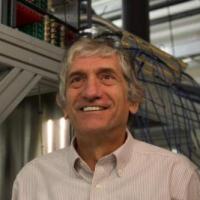SystemX Affiliates: login to view related content.

As microelectronics technology nears the end of exponential growth over time, known as Moore’s law, there is a renewed interest in new computing paradigms such as quantum computing. A key step in the roadmap to build a scientifically or commercially useful quantum computer will be to demonstrate its exponentially growing computing power. I will explain how a 7 by 7 array of superconducting xmon qubits with nearest-neighbor coupling, and with programmable single- and two-qubit gate with errors of about 0.2%, can execute a modest depth quantum computation that fully entangles the 49 qubits. Sampling of the resulting output can be checked against a classical simulation to demonstrate proper operation of the quantum computer and compare its system error rate with predictions. With a computation space of 2^49 = 5 x 10^14 states, the quantum computation can only be checked using the biggest supercomputers. I will show experimental data towards this demonstration from a 9 qubit adjustable-coupler “gmon” device, which implements the basic sampling algorithm of quantum supremacy for a computational (Hilbert) space of about 500. We have begun testing of the quantum supremacy chip.
John Martinis attended U.C. Berkeley from 1976 to 1987. His PhD thesis was a pioneering demonstration of quantum-bit states in superconductors. After postdoctoral research at CEA in France, he joined NIST Boulder where he developed electron counting devices and x-ray microcalorimeters. In 2004 he moved to U.C. Santa Barbara where he continued work on quantum computation. In 2014 he was awarded the London Prize for low-temperature physics research. In 2014 he joined the Google quantum-AI team and heads the hardware effort to build a useful quantum computer.


